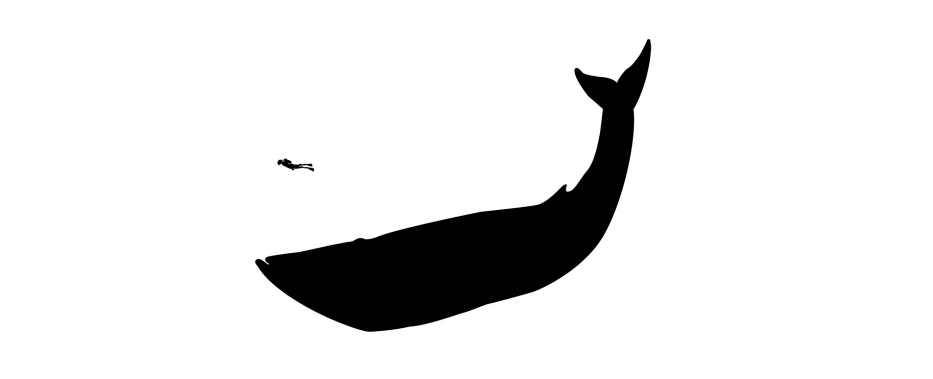The blue whale
1- Blue whale specifications

The blue whale is the largest mammal living on Earth. His body is long and large, 24 to 27 m long, and it can reach up to 30 m and weigh massively between 120 and 170 tons, possibly over 190 tons. His head is flat in the form of a Latin U, 6 or 7 m long, and a battering color to the blue, containing two double holes hidden by fat folds activated by powerful muscles.
This giant covers dark or light blue skin, showing light stains along the body except for the head and tail.
The bra fins are long and strong; they can be as long as 4 meters, and they’re white from the bottom. The fin is small, about 30 cm long, sickle or triangle, positioned in the third quarter from the mouth on the whale’s body. The tailfins are large and huge, with a length of 7.5 m and an area of 10 m2. The upper jaw contains 300 large black plates called ballin, which is 1 m long. He’s got throat-level abdominal folds that take water out of the whale’s mouth to pick food—60 to 90 folds.
2-Blue whale measurements
- Total length : 24 – 27 m
- Weight : 120 – 170 Tn
3-The size of a blue whale compared to a human.

4–Diet
What’s a blue whale eating?
The blue whale opens its mouth to enter water and krill animals, and then pushes the water out through the balin sheets that filter the plankton out of the water and take advantage of it. These whales feed in high-concentration areas of krill. During the day, the blue whale dives over 100 meters and feeds on the roof at night. It can also swallow other types of crustaceans, small fish, and pawheads. These whales are adapting to diving deep enough to search for their food and hunt their prey, but as a whole, the mammals return to the surface of the water to breathe. These whales can consume between 3 and 4 tons of krill a day.
Where does the blue whale live?
Blue whales live in all oceans except the Arctic Ocean. These whales are rarely near the coast and are generally observed at a depth of between 200 and 2,000 m. Blue whales are considered migratory species.
5-Countries where the blue whale is found
Morocco, Mauritania, Oman, Yemen, Somalia, Djibouti, Comoros, Iran, Angola, Argentina, Australia, Bangladesh, Bermuda, Brazil, Canada, Cape Verde, Chile, Cocos (Keeling) Islands, Colombia, Cook Islands, Costa Rica, Ecuador, El Salvador, Falkland Islands (Malvinas), Faroe Islands, Fiji, France, French Southern Territories, Greenland, Guatemala, Iceland, India, Indonesia, Ireland, Japan, Kenya, Kiribati, Madagascar, Malaysia, Maldives, Mauritius, Mexico, Mozambique, Myanmar, Namibia, Nauru, New Caledonia, New Zealand, Nicaragua, Norfolk Island, Norway, Pakistan, Palau, Panama, Papua New Guinea, Peru, Philippines, Portugal (Madeira, Azores), Russia (Kuril Islands, Kamchatka), La Réunion Island, San Pierre Miquelon, Senegal, Seychelles, Solomon Islands, South Africa, South Georgia and the South Sandwich Islands, Spain (Canary Islands), Sri Lanka, Svalbard and Jan Mayen, United Republic of Tanzania, Thailand, East Timor, Tuvalu, United Kingdom, United States, Uruguay, Vanuatu.

Breeding season:
Gestation period: 335–365 days
Number of litters: 01 every 02 or 03 years
Age of sexual maturity: 05–10 years
Blue whale metabolism:
Typical body temperature:
Basal metabolic rate:
Metabolic rate per body mass:
Maximum longevity: 80–90 years
Blue whale benefits :
The blue whale feeds on small crustaceans, and through this it regulates the communities of these species and thus the food chain, the extinction of the blue whale doubles the number of krills and thus disrupts ecosystems.
The blue whale at death is an enormous source of food – given its size – whether for whales when his body is drowned or for land animals also.
Blue whale fishing has been banned in many countries of the world, which have been benefiting from its flesh and oil, as its oil is used in the manufacture of soap and animal margarine.
What’s the reason for the blue whale screaming?
The blue whale makes distinctive sounds called calls, which vary in frequency, intensity and function, divided by scientists into four types, A, B, C and D, the call A being long and low in frequency, B being a nasty call, C being a tone call that goes up following B’s call, and D being a mid-term tone call.
distinctive sounds A and B are made only by males and believe that the function of these calls is related to mating. Call A comes from both males and females, and its function, according to scientists, is essentially related to communication between individuals.
Can a Human hear the blue whale?
Yeah, because the blue whale’s frequency is between 10 and 40 Hz, and the lowest one human can hear is usually 20 Hz.
Can a Human hear the blue whale?
Yeah, because the blue whale’s frequency is between 10 and 40 Hz, and the lowest one human can hear is usually 20 Hz.
What’s the blue whale’s breathing pattern?
The blue whale is mammalian and therefore has two lungs, which, unlike the fish, does not allow him to breathe underwater, though, he is able to hold his breath for about an hour and a half. The blue whale must rise to the surface to exhale and recover breath, during the exhalation process not only of air (carbon dioxide), but also of snot and water in the form of a remotely visible column, all coming out of a hole on its head called a blow hole, which is the necrosis of other
mammals.
How big is the blue whale’s heart?
The heart of the blue whale is the size of a small car, which can be heard from 3 kilometers away.







